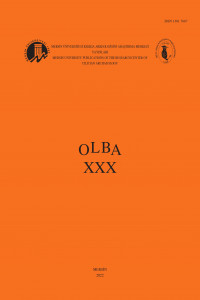Rhodian Amphora Stamps at the Foot of the Carpathians. New Evidences from the Dacian Settlement at Cetățeni
Öz
This paper is occasioned by the identification in museum collections of four Rhodian stamped
amphora handles discovered in the Dacian settlement from Cetățeni (Romania), which raises to
114 the quantity of Rhodian stamps known from here. This large number of Rhodian amphora
stamps compared to any other Dacian site is explained by the fact that the settlement of Cetățeni
(2nd century BC – 1st century AD), located at the southern foot of the Carpathians, controlled a
very important road that started from the Danube and crossed mountains to the north. The amount
of imports in general (pottery, ornaments, coins) in this settlement is high, and indicates clear
connections with the Mediterranean civilization, first with the Hellenistic world and then with the
Roman one. The batch of Rhodian amphora stamps from Cetățeni covers the periods III-VI, with
an obvious peak in the V period, in the decade 130-121 BC. The four new stamps are divided into
two of eponym (Andrias, who is one of the last eponyms of the period Va, and an illegible one) and
two of fabricant (both of them belonging to Linos).
Anahtar Kelimeler
Kaynakça
- Akamatis 2000 Akamatis, Ι. Μ., Ενσφράγιστες λαβές αμφορέων από την Αγορά της Πέλλας. Ανασκαφή 1980-1987. Οι ομάδες Παρμενίσκου και Ρόδου, Athens. www.amphoralex.org Centre Alexandrin d'Étude de Amphores, édition numérique de la base des matrices des éponymes et fabricants rhodiens.
Öz
Kaynakça
- Akamatis 2000 Akamatis, Ι. Μ., Ενσφράγιστες λαβές αμφορέων από την Αγορά της Πέλλας. Ανασκαφή 1980-1987. Οι ομάδες Παρμενίσκου και Ρόδου, Athens. www.amphoralex.org Centre Alexandrin d'Étude de Amphores, édition numérique de la base des matrices des éponymes et fabricants rhodiens.
Ayrıntılar
| Birincil Dil | İngilizce |
|---|---|
| Konular | Arkeoloji |
| Bölüm | Araştırma Makalesi |
| Yazarlar | |
| Yayımlanma Tarihi | 5 Mayıs 2022 |
| Yayımlandığı Sayı | Yıl 2022 Sayı: XXX |


